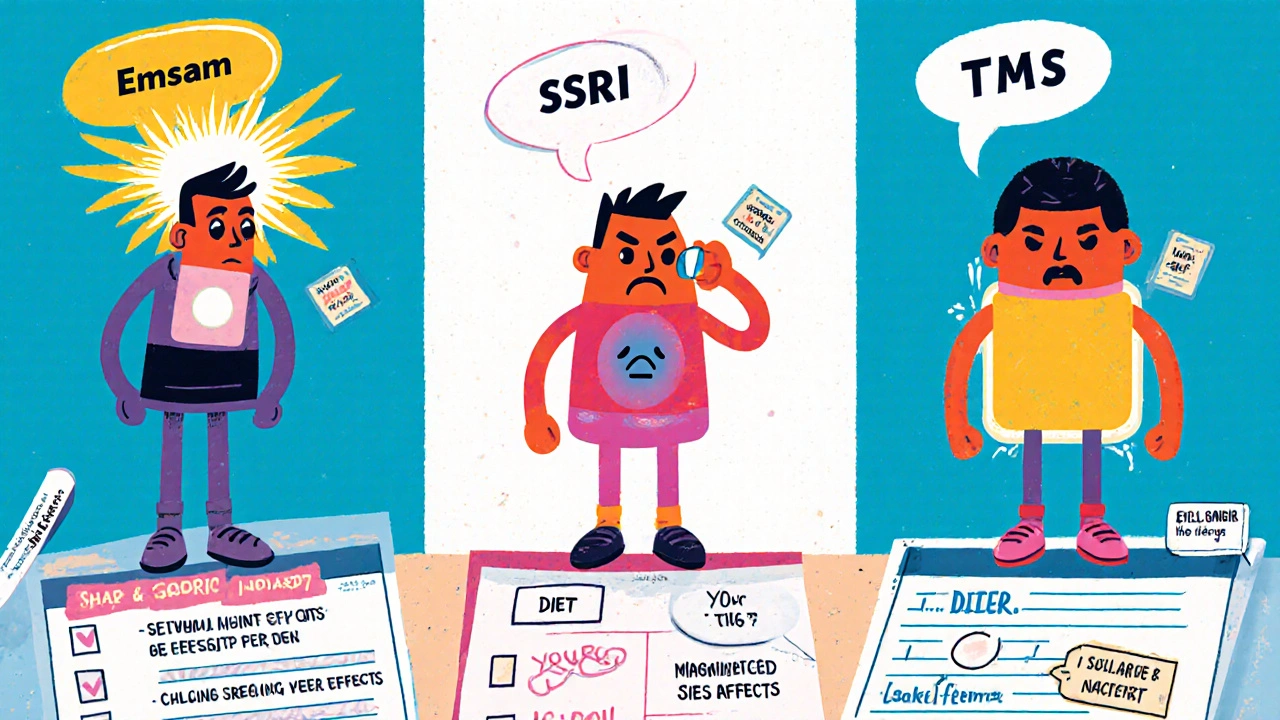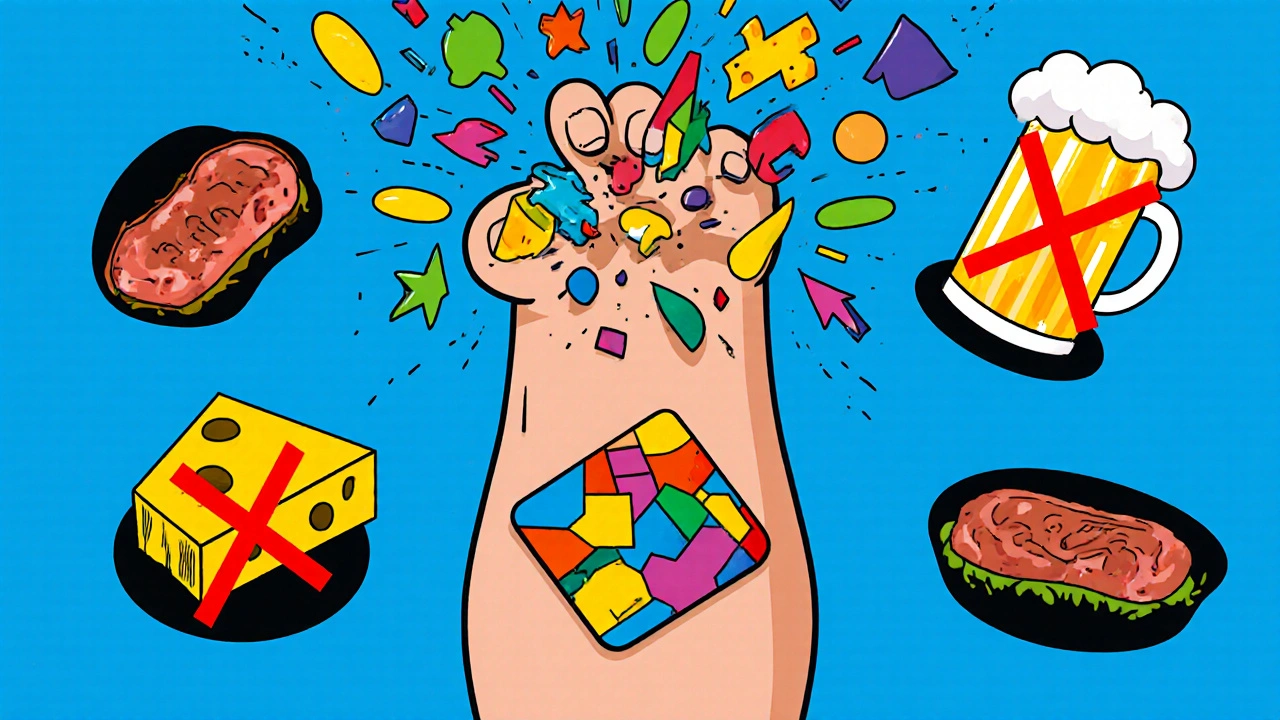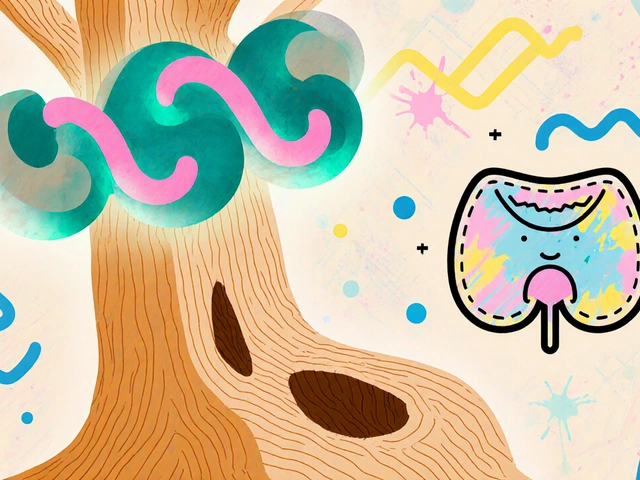Depression Treatment Comparison Tool
Personal Treatment Assessment
Your Recommended Options
Your treatment options will appear here after you submit your responses.
When you’re struggling with depression and standard antidepressants like SSRIs haven’t worked, your doctor might suggest Emsam (selegiline). It’s not your typical pill. Emsam is a skin patch that delivers selegiline, a type of antidepressant called an MAOI, directly into your bloodstream. But it’s not the only option. Many people wonder: how does Emsam stack up against other treatments? And if it doesn’t fit your life, what else actually works?
What Emsam Actually Does
Emsam contains selegiline, which blocks enzymes in your brain that break down serotonin, norepinephrine, and dopamine. By keeping these mood-boosting chemicals active longer, it helps lift depression. Unlike oral MAOIs, Emsam is applied as a patch once daily. That means less risk of stomach upset and fewer interactions with food - but not zero. The 6 mg patch lets you eat most foods normally. The 9 mg and 12 mg patches still require avoiding aged cheeses, cured meats, and tap beer. That’s because high tyramine levels can spike your blood pressure dangerously.
Studies show Emsam works for people who didn’t respond to other antidepressants. One trial found nearly 40% of patients had a meaningful improvement after six weeks. That’s higher than placebo, but not dramatically better than newer drugs. Still, for some, it’s the only thing that clicks.
How Emsam Compares to Other MAOIs
Emsam isn’t the only MAOI. Oral versions like phenelzine (Nardil) and tranylcypromine (Parnate) have been around since the 1950s. They’re cheaper and work well - but come with strict diets, more side effects, and daily dosing.
| Medication | Form | Dosing | Diet Restrictions | Common Side Effects |
|---|---|---|---|---|
| Emsam (selegiline) | Patch | Once daily | 6 mg: None; 9/12 mg: Limited | Skin irritation, insomnia, dizziness |
| Phenelzine (Nardil) | Oral tablet | 2-3 times daily | Strict: avoid aged cheese, wine, soy, cured meats | Weight gain, drowsiness, low blood pressure |
| Tranylcypromine (Parnate) | Oral tablet | 2 times daily | Strict: same as Nardil | Restlessness, dry mouth, insomnia |
For someone who hates swallowing pills or has trouble remembering doses, Emsam’s patch is a win. But if you’re on a tight budget, oral MAOIs cost far less - sometimes under $10 a month with insurance. Emsam can run over $400 without coverage. And if you’re sensitive to skin products, the patch might cause redness or itching. Some people quit because of that alone.
Emsam vs. SSRIs and SNRIs
Most people start with SSRIs like sertraline (Zoloft) or SNRIs like venlafaxine (Effexor). These are easier to use. No diet changes. Fewer dangerous interactions. Side effects like nausea or sexual problems are common, but usually fade.
But here’s the catch: up to one-third of people with depression don’t respond to SSRIs or SNRIs. That’s where Emsam comes in. A 2023 meta-analysis found MAOIs like selegiline had a higher response rate than SSRIs in treatment-resistant cases - especially when depression came with anxiety, fatigue, or oversleeping.
Still, doctors won’t jump to Emsam right away. It’s reserved after other options fail. Why? Because even though the patch reduces risks, mixing it with common meds like cold remedies, opioids, or even St. John’s wort can cause serotonin syndrome - a rare but life-threatening spike in brain chemicals.

Other Alternatives Beyond Antidepressants
Not everyone wants to take another drug. If Emsam sounds too risky or complicated, what else works?
- TMS (Transcranial Magnetic Stimulation): A non-invasive procedure that uses magnetic pulses to stimulate brain areas tied to mood. No pills. No diet rules. Sessions take 20-40 minutes, five days a week for 4-6 weeks. Insurance often covers it after two failed antidepressants.
- ECT (Electroconvulsive Therapy): Used for severe, life-threatening depression. It’s fast-acting - often helping in days. But it requires anesthesia and can cause temporary memory loss. It’s not for mild cases.
- Ketamine and esketamine (Spravato): Spravato is a nasal spray approved for treatment-resistant depression. It works fast - sometimes within hours. But it’s expensive, requires clinic visits, and can cause dizziness or dissociation.
- Therapy: CBT (Cognitive Behavioral Therapy) isn’t a drug, but it’s backed by decades of evidence. When combined with medication, it boosts long-term recovery. For people who hate pills, therapy alone can be enough - especially for mild to moderate depression.
Some people try supplements like omega-3s, vitamin D, or SAM-e. There’s weak evidence for SAM-e - it might help a little, but it can interact with MAOIs. Don’t mix it with Emsam. Ever.
Who Should Avoid Emsam
Emsam isn’t right for everyone. Avoid it if you:
- Have uncontrolled high blood pressure
- Take opioids like oxycodone or tramadol
- Use dextromethorphan (common in cough syrups)
- Are pregnant or breastfeeding (limited safety data)
- Have liver disease - selegiline is processed by the liver
- Are under 18 - it’s not approved for kids
Also, if you’ve had a bad reaction to any MAOI in the past, skip Emsam. The risk isn’t worth it.

When Emsam Might Be the Best Choice
Here’s when Emsam shines:
- You’ve tried at least two SSRIs or SNRIs with no results
- You struggle with daily pill routines
- You have atypical depression - oversleeping, overeating, heavy limbs
- You can’t tolerate weight gain or sexual side effects from other drugs
- You’re willing to follow the patch rules and avoid risky meds
One patient I know - a 42-year-old teacher in Perth - tried fluoxetine, bupropion, and venlafaxine. Nothing helped. She started Emsam 6 mg. Within three weeks, her energy returned. She didn’t need to change her diet. The patch stuck fine. She still gets mild skin redness, but it’s better than feeling numb all day.
How to Decide Between Emsam and Other Options
Ask yourself these questions:
- Have I tried at least two standard antidepressants without success?
- Do I mind applying a patch daily? Can I handle potential skin irritation?
- Am I on any other meds or supplements that could interact?
- Can I afford Emsam, or would an oral MAOI or TMS be more budget-friendly?
- Do I prefer a drug-free option like therapy or TMS?
If you answered yes to the first two and no to the rest, Emsam might be worth a try. If you’re unsure, start with TMS or therapy. They’re safer, and you can always add medication later.
What Happens If Emsam Doesn’t Work?
It’s not a guarantee. About 60% of people respond. That means 4 in 10 don’t. If you’ve tried Emsam for 8-12 weeks at the highest dose and feel no improvement, it’s time to pivot.
Options after Emsam:
- Switch to another MAOI like tranylcypromine
- Try esketamine (Spravato) - fast action, clinic-based
- Combine therapy with a different antidepressant class
- Consider ECT if symptoms are severe or suicidal
Don’t give up. Depression treatment often takes trial and error. What didn’t work before might work later, especially with new combinations or approaches.
Is Emsam better than other antidepressants?
Emsam isn’t better for everyone - but it can be more effective for people who didn’t respond to SSRIs or SNRIs. It’s especially helpful for those with atypical depression (oversleeping, overeating). The patch form makes it easier to use than older MAOIs, but it’s not first-line because of cost and potential side effects.
Can I drink alcohol with Emsam?
Small amounts of alcohol (like one glass of wine) are usually okay with the 6 mg patch. But higher doses (9 mg or 12 mg) increase the risk of dangerous blood pressure spikes. Avoid red wine, beer, and spirits entirely on higher doses. Always check with your doctor - alcohol can worsen dizziness and sleep problems.
How long does it take for Emsam to work?
Most people notice changes in energy or mood after 2-4 weeks. Full benefits often take 6-8 weeks. Don’t stop if you don’t feel better right away. Give it time, and track your symptoms daily.
Can I use Emsam with therapy?
Yes. In fact, combining Emsam with cognitive behavioral therapy (CBT) improves long-term outcomes. Therapy helps you manage negative thoughts and build coping skills, while Emsam helps balance brain chemicals. Together, they’re more powerful than either alone.
Is Emsam safe for long-term use?
Yes, if monitored by a doctor. Many people use Emsam for years without major issues. Regular check-ups are key - especially for blood pressure and liver function. Don’t stop suddenly; taper slowly under medical supervision to avoid withdrawal symptoms like anxiety or nausea.
If you’re considering Emsam or alternatives, talk to your doctor about your history, lifestyle, and goals. There’s no one-size-fits-all fix for depression. But with the right match - patch, pill, therapy, or device - relief is possible.


